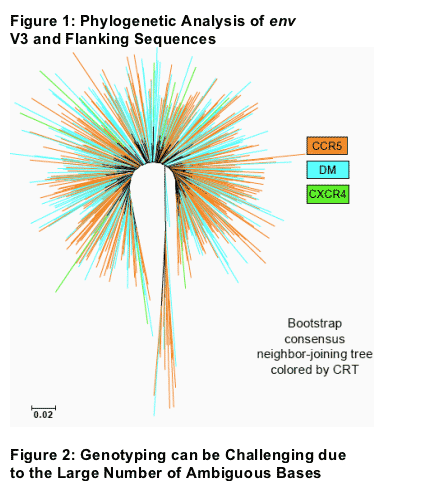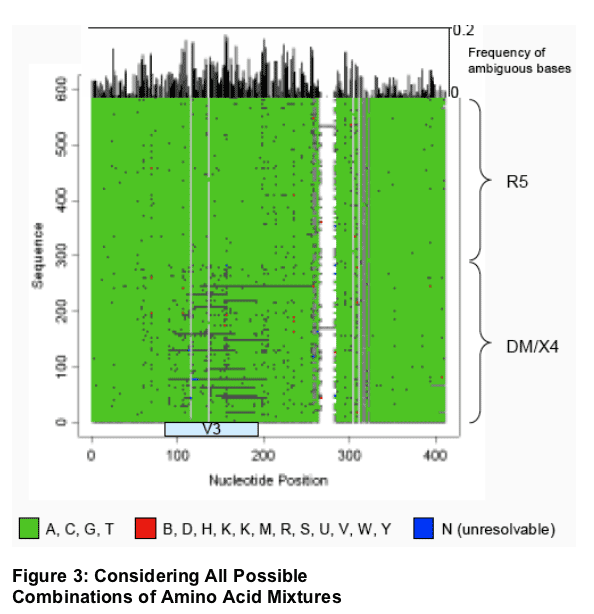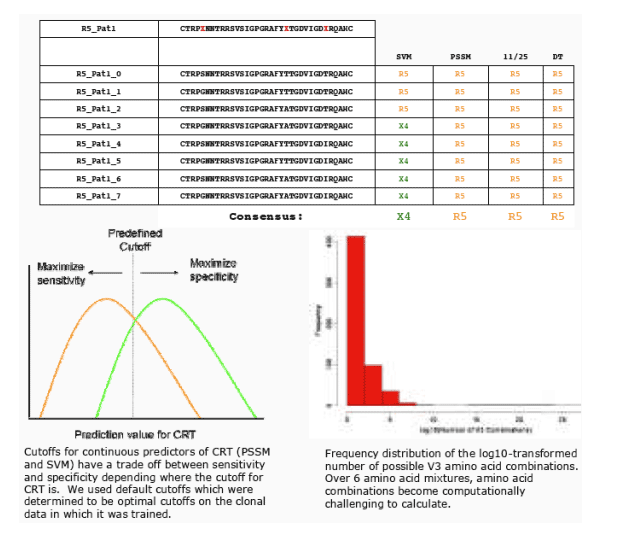 |
 |
 |
| |
Co-receptor Tropism Predictions Based on V3 Loop Sequence in Antiretroviral-Experienced Patients are Specific but Insensitive for the
Detection of CXCR4-using Variants
|
| |
| |
Reported by Jules Levin
ICAAC Sept 17-20, 2007, Chicago
E. STAWISKI, J. WHITCOMB, E. COAKLEY, S. FRANSEN, E. PAXINOS,
J. TOMA, T. WRIN, W. HUANG, N.PARKIN, C. CHAPPEY,
C.J. PETROPOULOS
Monogram Biosciences,
South San Francisco
CA USA.
RESULTS
Based on Trofile™ results, approximately half of the samples were defined as CXCR4-using
CRT predictions used a combinatorial strategy which allowed V3 sequences with mixtures and up to 100 possible combinations to be included
However V3 sequences containing very large numbers of mixtures, i.e., >100 possible combinations, could not be analyzed and were excluded, with loss of 26% of the dataset
Among the remaining analyzable sequences sensitivity for CXCR4-using HIV was poor (24-56%)
CRT prediction specificities were generally high (81-99%)
Overall discordance within a given dataset ranged from 22-28%
AUTHOR CONCLUSIONS
In treatment-experienced patients, envelope sequencing interpretation and tropism prediction is commonly hampered by extreme diversity in variable subpopulations of viruses.
Currently, state of the art interpretation algorithms significantly under-report the presence of CXCR4-using virus.
BACKGROUND
- Interest in co-receptor tropism (CRT) assays is growing with the availability of CCR5 antagonists for treatment of HIV-1 infection.
- The Trofile™ CRT assay1 is being used extensively to support the pre-clinical and clinical development of CRT antagonists.
- The performance of genotype assays in heavily treatment-experienced patients, which is the likely target population for CCR5 antagonists, is unknown.
- V3 region genotype based methods such as the modified 11/25 Charge Rule2, Decision Trees3, Position Specific Scoring Matrices (PSSM)4, and Support Vector Machines (SVM)3 have been primarily trained and tested on clonal sequences from subtype B sequences
- Previous studies have highlighted technical difficulties in obtaining high quality envelope sequence and limitations of interpretation systems.
METHODS
- Samples from triple-class (NRTI/NNRTI/PI) experienced patients were studied (N = 587).
- CRT was determined by the Trofile™ assay and reported as CCR5, CXCR4, or dual/mixed (DM).
- The data set consisted of 300 CCR5, 277 DM and 10 CXCR4 CRT viruses.
- Population V3 loop sequences were determined using conventional sequencing techniques.
- A total of 27 samples (4.6%) had V3 genotypes that were considered unreportable and not analyzed further
- CRT was predicted (CCR5 only or CXCR4 using) according to published algorithms, the SVM was trained on publicly available data from the Los Alamos
National Laboratory HIV database.
CRT V3 Genotype Prediction Definitions:
To evaluate CRT genotype-based predictions, viruses are classified as CCR5-using and DM or CXCR4 -using. All CRT predictions were compared to the corresponding phenotypic CRT determined by Trofile™.
Sensitivity = Number of correctly predicted CXCR4-using viruses ÷ Total number of CXCR4-using viruses
Specificity = Number of correctly predicted R5viruses ÷ Total number of R5 viruses
Discordance = Total percentage of data set incorrectly predicted
Trofile™ as the Reference Phenotype Assay
Recent clinical trials highlight the utility of the Trofile™ assay to determine tropism prior to CCR5 co-receptor tropism antagonist use.
The ACTG 5211 and MOTIVATE trials compared the activity of a CCR5 co-receptor tropism antagonist versus placebo in treatment-experienced individuals with R5 HIV by Trofile™ and who also received an optimized background regimen.
-- In ACTG 5211 70%-73% of individuals receiving vicriviroc had week-24 HIV-1 RNA levels <400 copies/mL compared to 18% in the placebo arm5.
-- In the MOTIVATE 1 and 2 trials 61% of individuals receiving twice daily maraviroc had week-24 HIV-1 RNA levels <400 copies/mL arms compared to 28% in the placebo arms6,7,8.
Conversely, the A4001029 study compared the activity of maraviroc versus placebo in treatment experienced individuals with D/M or X4 tropism who received an optimized background regimen9. In this study there were no significant differences in HIV-1 RNA outcomes in the maraviroc group compared to those receiving placebo, highlighting the limited antiviral activity of this drug class in the setting of non-R5 tropism.
Estimation of the positive and negative predictive value (PPV, NPV) of the Trofile™ assay is hampered by the difficulty in accounting for differences in the optimized background therapy for individual patients.
The PPV is largely impacted by the sensitivity to detect low level CXCR4-using variants, which is in turn influenced by disease stage and treatment history. A reasonable estimate of PPV can be based on the percentage of patients in a given population with CXCR4-using minor variants near the limit of detection of the Trofile™ assay:
-- ARV-naive patients: 95 - 97%
-- ARV-experienced patients: 90 - 95%
NPV approaches 100%. This estimate is based on the observation from the Pfizer A4001029 trial that among individuals with D/M or X4 HIV the observed
HIV RNA responses in the maraviroc and placebo groups were not different9.


Figure 3: Considering All Possible
Combinations of Amino Acid Mixtures
Due to sequence ambiguities that result in more than one amino acid at a single
position, one strategy is to generate all possible combinations of V3 sequences
and perform CRT genotype predictions on all sequences (example below). Other
studies have used arbitrary cutoffs for the minimum percentage needed to have
that particular CRT (≥25 %).

REFERENCES
1. Whitcomb J.M., Huang W., Fransen S., Limoli K., Toma J., Wrin T., Chappey C., Kiss L.D., Paxinos E.E., Petropoulos C.J. Antimicrob Agents Chemother. 51:566-75, 2007.
2. Hoffman, N.G., Seillier-Moiseiwitsch F., Ahn J., Walker J. M., Swanstrom R. J.
Virol. 76:3852-3864, 2002.
3. Pillai S., Good B., Richman D., Corbeil J. AIDS Res Hum Retroviruses. 19:145-9, 2003.
4. Jensen, M.A., Li F.-S., van 't Wout A.B., Nickle D.C., et al. J. Virol. 77:13376-
13388, 2003..
5. Gulick R.M., Su Z., Flexner C. J. Infect. Dis. 196:304-31, 2007.
6. Lalezari J, Goodrich J, DeJesus E, et al. Abstract 104bLB, 14th Conference on
Retroviruses and Opportunistic Infections; February 25-28, 2007; Los Angeles.
7. Nelson M, Fätkenheuer G, Konourina I, et al. Abstract 104aLB, 14th Conference on Retroviruses and Opportunistic Infections; February 25-28, 2007; Los Angeles.
8. Van der Ryst E, Cooper D, Konourina I, et al. Abstract WEPEB115LB, 4th
International AIDS Society Conference on HIV Pathogenesis, Treatment and
Prevention; July 22-25, 2007; Sydney, Australia
9. Mayer H, van der Ryst E, Saag M, et al. Abstract THLB0215, XVI International
AIDS Conference; August 13-18, 2006; Toronto, Canada.
|
| |
|
 |
 |
|
|